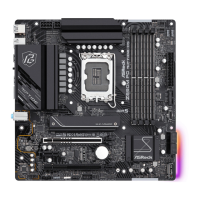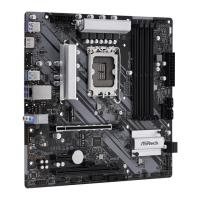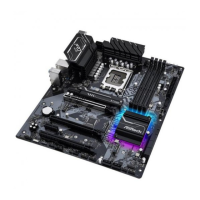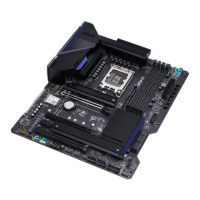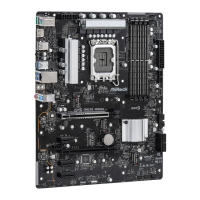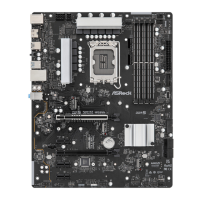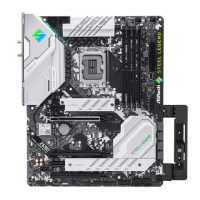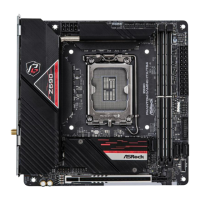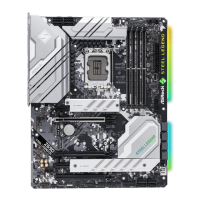
Do you have a question about the ASROCK Z690M-ITX/ax and is the answer not in the manual?
| Processor socket | LGA 1700 |
|---|---|
| Processor manufacturer | Intel |
| Compatible processor series | Intel Core i5, Intel Core i7, Intel Core i9 |
| Non-ECC | Yes |
| Memory channels | Dual-channel |
| Memory slots type | DIMM |
| Number of memory slots | 2 |
| Supported memory types | DDR4-SDRAM |
| Maximum internal memory | 32 GB |
| Supported memory clock speeds | 5000 MHz |
| RAID levels | 0, 1, 5, 10 |
| Number of storage drives supported | 6 |
| Supported storage drive interfaces | M.2, SATA III |
| Parallel processing technology support | - |
| USB 2.0 connectors | 1 |
| Number of SATA III connectors | 4 |
| USB 3.2 Gen 2 (3.1 Gen 2) connectors | 0 |
| DisplayPort version | 1.4 |
| USB 2.0 ports quantity | USB 2.0 ports have a data transmission speed of 480 Mbps, and are backwards compatible with USB 1.1 ports. You can connect all kinds of peripheral devices to them. |
| LAN controller | Dragon RTL8125BG, Intel I219-V |
| Wi-Fi standards | 802.11a, 802.11b, 802.11g, Wi-Fi 4 (802.11n), Wi-Fi 6E (802.11ax) |
| Top Wi-Fi standard | Wi-Fi 6E (802.11ax) |
| Ethernet interface type | 2.5 Gigabit Ethernet |
| Audio chip | Realtek ALC897 |
| Component for | PC |
| Motherboard chipset | Intel Z690 |
| Audio output channels | 7.1 channels |
| Motherboard form factor | mini ITX |
| Windows operating systems supported | Windows 10 x64, Windows 11 x64 |
| BIOS type | EFI AMI |
| ACPI version | 6.0 |
| BIOS memory size | 256 Mbit |
| System Management BIOS (SMBIOS) version | 2.7 |
| Cables included | SATA |
| Harmonized System (HS) code | 84733020 |
| Weight | 981 g |
| Width | 170 mm |
|---|---|
| Height | 70.1 mm |
Lists all items included in the motherboard package.
Details the technical specifications of the motherboard components.
Visual guide to the motherboard's components and connectors.
Identifies and describes the rear panel input/output ports and connectors.
Details the onboard Wi-Fi 6E module and antenna setup.
Step-by-step guide for safely installing the CPU into the socket.
Instructions for mounting the CPU cooler and heatsink assembly.
Guide on how to correctly install DDR4 DIMM memory modules.
Information about the available PCI Express slot for expansion cards.
Details on configuring motherboard jumpers, specifically the Clear CMOS jumper.
Explains the purpose and connection of various onboard headers and connectors.
Information about the BIOS Flashback button and its usage.
Step-by-step guide for installing M.2 SSDs.
Guide on installing necessary drivers from the support CD.
Explains the features and usage of the A-Tuning utility.
Information about the ASRock utility for downloading software and updates.
Details the Nahimic audio software for enhanced sound performance.
Guide to customizing RGB lighting effects with the Polychrome SYNC utility.
Overview of the UEFI setup utility and how to access it.
Explains the default EZ Mode interface for basic system status monitoring.
Overview of the Advanced Mode for detailed BIOS configuration options.
Describes the main menu bar options within the UEFI setup utility.
Lists and explains the keyboard navigation keys for the UEFI utility.
Details the system overview displayed on the UEFI Main screen.
Guide to configuring overclocking settings for CPU, Cache, and Memory.
Introduction to advanced configuration sections like CPU, Chipset, Storage, ACPI, USB, and Trusted Computing.
Settings related to CPU features, performance, and power management.
Configuration options for the motherboard chipset and integrated peripherals.
Settings for SATA controllers, modes, and SMART technology.
Power management settings related to ACPI states and wake-up events.
Options for USB support, Legacy USB, and XHCI hand-off.
Settings for security features like TPM and PCR banks.
Access to various utilities like RAID installer, Secure Erase, and BIOS update.
Displays system hardware status, temperatures, fan speeds, and voltages.
Options for setting supervisor/user passwords and configuring Secure Boot.
Configuration of boot options, priorities, and Fast Boot settings.
Options for saving changes, discarding changes, and loading default settings.
